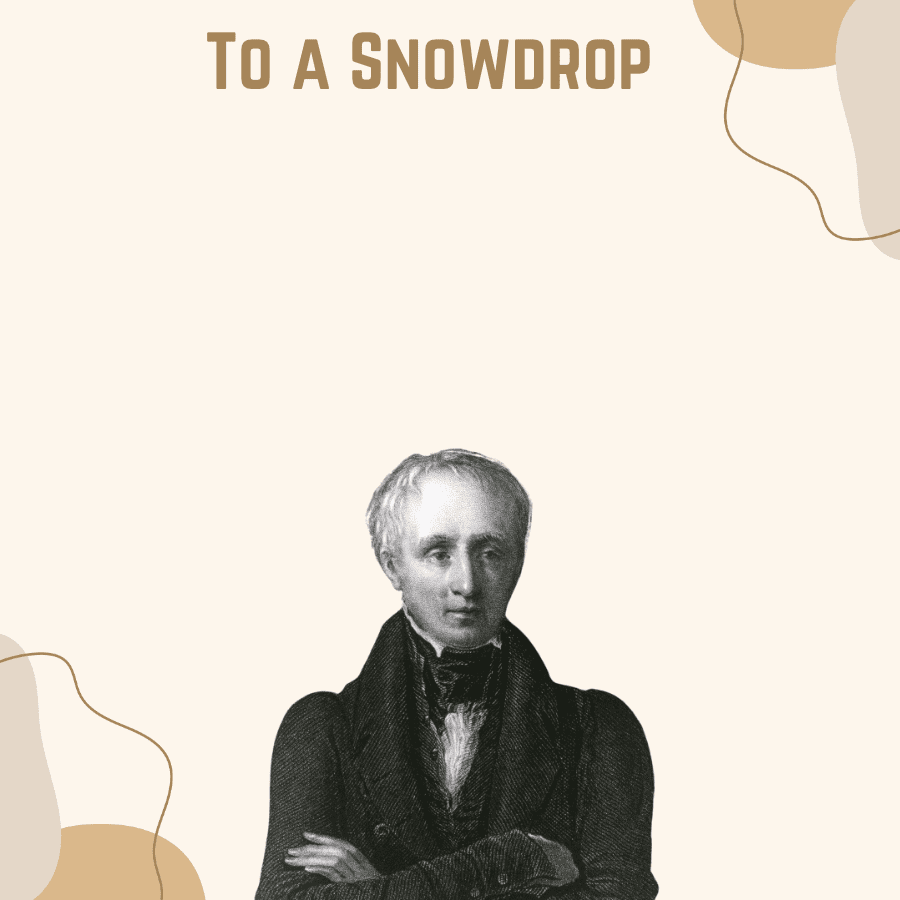William Wordsworth is a giant when it comes to poetry. One of the most popular poets of all time, Wordsworth has created some of the most memorable poems. “To a Snowdrop” is one such poem.
As with almost all the poems by Wordsworth, “To a Snowdrop” is a poem that appreciates the beauty of nature. Wordsworth sees what the normal person does not, and he expresses what a normal person cannot.
‘To a Snowman” is a poem that needs to be analyzed to show the complexities and interesting aspects of how Wordsworth explains natural sights.
Here’s the poem and following that, the analysis and meaning of it.
To a Snowdrop by William Wordsworth
Lone Flower, hemmed in with snows and white as they But hardier far, once more I see thee bend Thy forehead, as if fearful to offend, Like an unbidden guest. Though day by day, Storms, sallying from the mountain-tops, waylay The rising sun, and on the plains descend; Yet art thou welcome, welcome as a friend Whose zeal outruns his promise! Blue-eyed May Shall soon behold this border thickly set With bright jonquils, their odors lavishing On the soft west-wind and his frolic peers; Nor will I then thy modest grace forget, Chaste Snowdrop, venturous harbinger of Spring, And pensive monitor of fleeting years!
What “To a Snowdrop” Means
“To a Snowdrop” is a poem that talks about the sight of a single snowflake in a heap of snow. Wordsworth says that just like a flower in a pile of snow, the snowflake sits.
While it is just as white as the snow, it is far more hardier, and stronger. But yet, he notices that the snowfall is ‘bending’ its forehead. This ‘bending’ refers to the slow melting of the snowflake.
Even though every day the storm comes down from the mountain tops, covering the sunlight, it is always a welcoming sight to see you, the snowflake. The snowflake gets more ahead than it can, for it melts quickly.
Even though with the approach of May, the fields will be filled with bright flowers, covering the entire place with their fragrance with the warm winds from the west, I will not forget the modest grace of the snowflake.
The snowdrop is pure and quite brave to move ahead and bring the news of the coming spring. It is the snowdrop that observes the passing of time, thoughtfully.
The Beauty of Nature
The central theme of the poem is the beauty of nature. Wordsworth is fascinated by the intricate details of the snowflake. How nature has created somewhat of a flower with just water.
He also shows how beautiful things can occur in the smallest of places and in the shortest periods. Him watching a single snowflake slowly melting away and the beauty that it has.
Wordsworth also personifies the snowflake to make it more emotionally impactful and connect it to the readers even more deeply.
The Passage of Time
Nature and the passage of time are deeply connected in this poem. Wordsworth uses the melting of a single snowflake to show the changing of seasons and the passing of time.
The snowflake is said to be a pensive observer of the change of time. But why ‘pensive’? The pensiveness of the snowflake comes from the journey it has taken.
The snowflake has seen the winter and now is ready to be turned into the water with the coming of spring. It is almost as if the snowflake is dying and turning into another form. The snowflake is old.
The Beauty in the Cold
Another important aspect of this poem is how Wordsworth says that even after the coming of spring, he will not forget the modest beauty of the snowdrop.
This line signifies something important. The snowdrop is a testament to how beauty exists even in places that seem cold and dead.
A heap of snow looks cold and dead, but the snowdrop is a testament that beauty, albeit modest, exists even in that. The cold and dry winter might be dead to the eye, but deep inside, beauty is present.
Theme and Essence of the Poem
The theme of the poem is the passage of time, the beauty of nature, and how these two are closely related to one another. With the passage of time, the beauty of nature changes from one form to the other.
While it seems that the winter does not have any flowers to show as the flamboyant spring does, it does have these modest ‘flowers’ of snowdrops that are beautiful and brave.
Read more by William Wordsworth: To a Butterfly by William Wordsworth; Analysis
